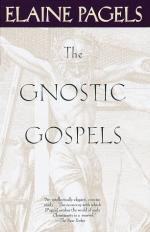
|
| Name: _________________________ | Period: ___________________ |
This test consists of 15 multiple choice questions and 5 short answer questions.
Multiple Choice Questions
1. In the works of the philosopher, Nietzsche, he speaks of Jesus as being the only true _____________.
(a) Gnostic.
(b) Christian.
(c) Believer.
(d) Lover.
2. There is even some suggestion in Gnostic texts that man himself creates the world of ___________, something radical even for the Gnostic beliefs.
(a) God.
(b) Man.
(c) Pain.
(d) Life.
3. After the death of Jesus, a ______________ soldier was the one who started the riot in the Temple, causing many deaths in the process.
(a) Muslim.
(b) Christian.
(c) Greek.
(d) Roman.
4. The Gnostic author had nothing but contempt for a congregation of seekers that sought to avoid the firm citadel of Christan ___________.
(a) Crucifixion.
(b) Communion.
(c) Blasphemy.
(d) Confession.
5. __________ united Gnostic brethren together and that brotherhood was paramount, not the obedience to any clergy.
(a) God's laws.
(b) Gnosis.
(c) Jesus.
(d) The Bible.
6. In the Gospel of Thomas, _________ speaks of a light within man that can light up the whole world.
(a) Peter.
(b) Jesus.
(c) God.
(d) Thomas.
7. Phillip in his gospel laughs at the _________________ as a test of spiritual sufficiency, as people receive nothing from this.
(a) Eucharist.
(b) Reconciliation.
(c) Baptism by water.
(d) Communion.
8. It is thought that perhaps some of the texts which were to be destroyed were buried in a _______ where they were later found.
(a) Statue.
(b) Jar.
(c) Box.
(d) Well.
9. Justin was a philosopher who wrote to the Emperor protesting the treatment of a __________________.
(a) Whore.
(b) Christian woman.
(c) Christian man.
(d) Disciple of Jesus.
10. Citizens were _____________ immediately, but those who were non-citizens were tortured in public stadiums.
(a) Shot.
(b) Poisoned.
(c) Tortured.
(d) Beheaded.
11. The Christian, as a result of learning about Gnosticism might ask what the true source of _____________ is in the Church.
(a) Faith.
(b) Enlightenment.
(c) Authority.
(d) Truth.
12. To the Gnostics, the body of the orthodox church, the mass of _________ believers was outside of the true Church.
(a) Faithful.
(b) Committed.
(c) True.
(d) Dumb.
13. The orthodox Christian looks at _____________ as a consequence of disbelief and of sin.
(a) Confusion.
(b) Happiness.
(c) Gnosticism.
(d) Suffering.
14. What is another thing the many criteria did for the orthodox church? It consolidated ______________.
(a) Power.
(b) Beliefs.
(c) Priests.
(d) Celebrants.
15. The Testimony of Truth talks about the ideas of ___________ and economic renunciation as components of a holy life.
(a) Giving money to the coffers.
(b) Sexual abstinence.
(c) Priesthood.
(d) Prayer.
Short Answer Questions
1. The Valentinians who led normal lives still regarded ____________ as their primary goal, even as they gave up some worldly pleasures.
2. Pagels is quick to point out that this book is not an argument for _______________, but a call to learning more.
3. One argument against the orthodox is that Christians refuse to truly seek God who can only be found in the fulfillment of the _________.
4. The Christan world, it could be said, was and continues to be one of __________ reality.
5. Justin speaks of a woman who was converted to Christianity by her teacher, ______________, and then she was a better person.
|
This section contains 461 words (approx. 2 pages at 300 words per page) |

|




